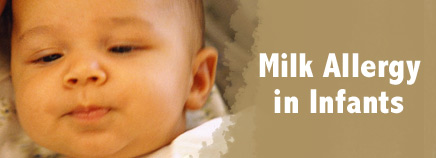
About Milk Allergy
People of any age can have a milk allergy, but it’s more common in infants (affecting about 2% to 3% of babies). Many kids outgrow it, but some don’t.
When a baby is allergic to milk, it means that his or her immune system, which normally fights infections, overreacts to proteins in cow’s milk (the basis for most commercial baby formulas). Every time the child has milk, the body thinks these proteins are harmful invaders and works very hard to fight them. This causes an allergic reaction in which chemicals like histamine are released in the body.
Babies often show their first symptoms of a milk allergy days to weeks after they’re first given cow milk-based formula. Breastfed infants have a lower risk of having a milk allergy than those who are formula fed. If they are allergic, though, they can have symptoms if mom has dairy products in her diet.
A milk allergy is not the same thing as lactose intolerance, which is when the body has trouble digesting milk.
Some babies with a milk allergy have an allergic reaction soon after having milk; others have problems hours or days later. If your baby has a milk allergy that causes symptoms soon after he or she has milk, keep two epinephrine auto-injectors on hand in case of a severe reaction (called anaphylaxis). An epinephrine auto-injector is an easy-to-use prescription medicine that comes in a container about the size of a large pen. Your doctor will show you how to use it.
Symptoms of a Milk Allergy
In children who show symptoms shortly after they have milk, an allergic reaction can cause:
- wheezing
- trouble breathing
- coughing
- hoarseness
- throat tightness
- stomach upset
- vomiting
- diarrhea
- itchy, watery, or swollen eyes
- hives
- red spots
- swelling
- a drop in blood pressure causing lightheadedness or loss of consciousness
A milk allergy can cause different symptoms at different times. Some reactions are mild and involve only one system of the body (like hives on the skin). But mild reactions in the past do not mean a child won’t have a serious allergic reaction next time.
Children who do not have symptoms shortly after they have milk can have a different type of reaction that causes problems hours to days later, such as:
- loose stools (possibly with blood)
- vomiting or gagging
- refusal to eat
- irritability or colic
- skin rashes, like eczema
If Your Child Has a Serious Reaction
If your child starts having serious allergic symptoms, like swelling of the mouth or throat or difficulty breathing, or symptoms involving two different parts of the body, like hives with vomiting:
- Give the epinephrine auto-injector right away. Every second counts in an allergic reaction.
- Then, call 911 or take your child to the emergency room. Your child needs to be under medical supervision because, even if the worst seems to have passed, a second wave of serious symptoms can happen.
Diagnosing a Milk Allergy
If you think your infant is allergic to milk, call your baby’s doctor. He or she will ask you questions and talk to you about what’s going on. After the doctor examines your baby, some stool tests and blood tests might be ordered. The doctor also may refer you to an allergist (a doctor who specializes in treating asthma and allergies).
The allergist may do skin testing. During skin testing, the doctor or nurse places a tiny bit of milk on the skin, then pricks the outer layer of skin or makes a small scratch on the skin. If your child reacts to the allergen, the skin will swell a little in that area.
If the allergist finds that your baby is at risk for a serious allergic reaction, epinephrine auto-injectors will be prescribed.
Avoiding a Milk Allergy Reaction
If You’re Breastfeeding
If your breastfed infant has a milk allergy, it’s important for you to avoid dairy products because the milk protein that causes allergic reactions can cross into your breast milk. Be sure to read food labels carefully. All food makers are required to clearly state whether a food contains milk or milk-based products — look for this in or next to the ingredient list on the packaging.
You may want to talk to your doctor or a dietician about finding alternative sources of calcium and other vital nutrients to replace what you were getting from dairy products.
If You’re Formula Feeding
If you’re formula feeding, your doctor may advise you to switch to an extensively hydrolyzed formula in which the proteins are broken down into particles so that the formula is less likely to trigger an allergic reaction.
You also might see “partially hydrolyzed” formulas, but these aren’t truly hypoallergenic and can lead to a significant allergic reaction.
Do not try to make your own formula. Commercial formulas are approved by the U.S. Food and Drug Administration (FDA) and created through a very specialized process that cannot be duplicated at home. Other types of milk that might be safe for an older child with a milk allergy (like rice milk, almond milk, or coconut milk) are not safe for infants.
If you have any questions or concerns, talk with your child’s doctor.

